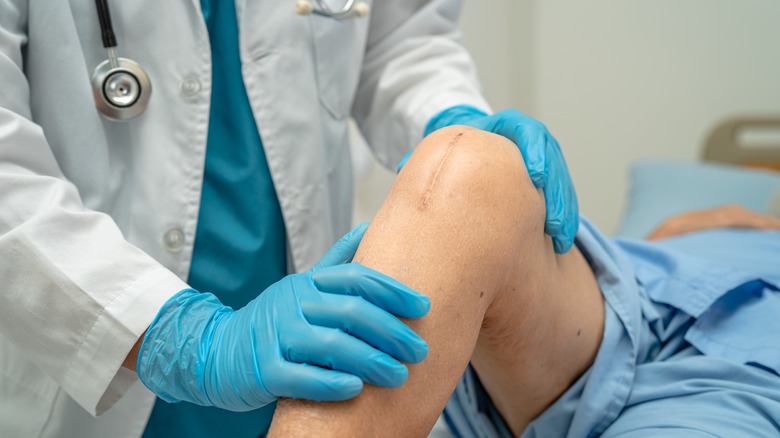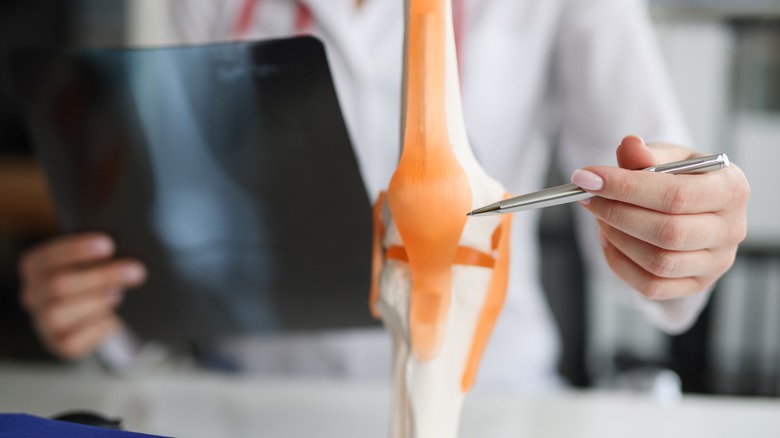What To Expect After A Knee Replacement, According To An Orthopaedic Surgeon
Most common amongst middle-aged and older adults, approximately 800,000 knee replacement surgeries take place annually across the country, reports the Cleveland Clinic. To find out what the recovery process entails following knee replacement surgery, Health Digest spoke with Kevin R. Stone, MD, Orthopaedic Surgeon at The Stone Clinic in San Francisco, Chairman of the Stone Research Foundation, and Member of the ACL Study Group, a leading collection of select surgeons from around the world specializing in ACL surgery, rehabilitation, and research. He is also Chairman of The Meniscus Transplant Study Group and Head of the Robotic Surgery Center at The Stone Clinic.
Dr. Stone begins by explaining what's involved in knee replacement surgery. "Traditional knee replacements usually entailed significant bone resections at the femur and tibia in the knee joint followed by cement fixation of metal devices with a polyethylene tray," he states. In some cases, he explains, ligaments were also sacrificed.
However, the procedure has changed substantially over the years. "In our hands with robotic precision, significantly less bone needs to be resected, most ligaments preserved, the kneecap left alone, and devices that have porous undersurfaces can be used to induce the patient's own bone to grow into the implants eliminating the cement," Dr. Stone explains. "This precision was not routinely possible before robotic arms were introduced approximately 15 years ago. The operation is now more like a resurfacing than a replacement."
What happens during the surgery
Dr. Stone then explains the step-by-step process that patients undergo during knee replacement surgery. "Our version of robotically controlled knee resurfacing is done at an outpatient surgery center," he states. "The patient['s] knee is exposed through a minimally invasive technique[.] [R]obotic arrays are attached and the knee virtually connect[s] to the robotic arm in space," he says.
Dr. Stone then explains that the knee is taken through a series of movements. "The knee can be taken through a range of motion and the patient's individual ligaments balanced so that the most minimal bone is resected, and except for the ACL, no ligament releases are performed," he says.
Finally, the implants are placed and the procedure comes to a close. "The implants are impacted into place on top of the freshened bone surfaces, long-acting pain-eliminating gels are injected, the knee tissues closed and the patient then returns to the post-operative area usually discharged full weight bearing after an hour," Dr. Stone states.
What rehabilitation looks like for patients
"Patients after our robotic cementless knee resurfacing return to our rehabilitation team the next day for one hour of physical therapy and one hour of fitness training," Dr. Stone goes on to tell Health Digest. Patients then continue this process regularly for approximately three to four months. "Most give up crutches after a few days, start well-leg biking on day one, upper body and core fitness training immediately and two-leg biking by two weeks," Dr. Stone states. However, for swimmers, the waiting period is a bit longer before they can return to the water. "Pool exercises wait until the wounds are completely dry and any stitches removed usually at three to four weeks," he says.
"Dedicated patients come into the clinic every day. Others work with our rehab team remotely after the initial care," Dr. Stone states. "With the long-acting pain gels, most patients do not need narcotics," he points out. In time, Dr. Stone says that patients are able to fully resume everyday activities as well as recreational sports. "Driving is permitted as soon as they feel safe," he says. "Many patients now return to full sports including running, hiking, skiing, and tennis."
Signs to look out for during recovery
Dr. Stone states that the procedure involves only a few hours in the surgery center before patients are able to head home. From there, depending on a patient's health status, how much follow-up care they may need can vary. "Since most patients with severely arthritic knees have walked with a limp and developed muscle weakness we advise 4-6 months of physical therapy and fitness training," Dr. Stone states.
While surgeons work diligently to prevent complications following surgery, Dr. Stone highlights what signs patients should be on the lookout for during recovery that may indicate a call to their medical team is needed. "As with any surgery, bleeding, blood clots, and infection are the problems we go to great lengths to avoid," he says. "Unusual pain, swelling, redness, shortness of breath, [and] fever are the usual initial signs of a problem." However, he points out that such occurrences are uncommon. "Fortunately, due to the immediate weight bearing, on-site physical therapy and fitness training, daily supervision, and minimal surgical exposures; these problems are now rare," he concludes.
To learn more about Dr. Stone, visit The Stone Clinic's Robotic Joint Center.




